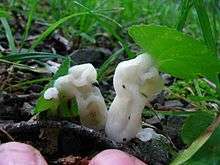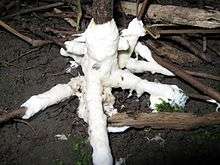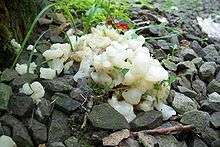Sebacina
Sebacina is a genus of fungi in the family Sebacinaceae. Its species are mycorrhizal, forming a range of associations with trees, orchids, and other plants. Basidiocarps (fruit bodies) are produced on soil and litter, sometimes partly encrusting stems of living plants. The fruit bodies are cartilaginous to rubbery-gelatinous and variously effused to coral-shaped. The genus has a cosmopolitan distribution, but fewer than a dozen species are currently recognized worldwide.
| Sebacina | |
|---|---|
 | |
| Varying forms of Sebacina concrescens | |
 | |
| Scientific classification | |
| Kingdom: | |
| Division: | |
| Class: | |
| Order: | |
| Family: | |
| Genus: | Sebacina Tul. & C.Tul. (1871) |
| Type species | |
| Sebacina incrustans (Pers.) Tul. & C.Tul. (1871) | |
| Synonyms[1] | |
Taxonomy
The genus was first published in 1871 by Louis and Charles Tulasne who had discovered that two species (Sebacina incrustans and S. epigaea) previously referred to Corticium or Thelephora possessed septate basidia, similar to those found in the genus Tremella. Although it was unusual at that time to separate fungal genera on purely microscopic characters, Sebacina was erected for effused, Corticium-like fungi with tremelloid basidia.[2]
Subsequent authors added many additional species to the genus. Most, however, proved unrelated to Sebacina and were removed in 1957 by Ervin, who shuffled some species to Heterochaetella (for example, Heterochaetella dubia, now Stypella dubia (Bourdot & Galzin) P. Roberts), Bourdotia and Exidiopsis.[3] In 1961, Wells also transferred many species to the genus Exidiopsis.[4] The type species, S. incrustans, has a variable morphology, which has led to it being assigned a number of names.[3][5]
Recent molecular research has shown that Sebacina is far more diverse than previously assumed, though this genetic diversity may not be reflected in morphological characters (in other words, species may be impossible to distinguish except by DNA analysis). The same research also shows that the genus splits into two groups, one clustered with the type species, the other clustered with a species sometimes referred to as "Sebacina vermifera" (though this is a misidentification). This latter species is distinct in forming thin, waxy fruit bodies and the group may not be part of Sebacina in the strict sense. Even in the strict sense, Sebacina is artificial, not being clearly distinct from related genera such as the coral-like Tremellodendron.[6]
Description
Fruit bodies are typically cartilaginous or rubbery-gelatinous. In effused species (those that spread out loosely or flat), they are formed on the soil surface or in leaf litter, often encrusting fallen twigs and debris, sometimes encrusting the stem bases of living plants. In the type species, irregular or coral-like outgrowths may also be produced.[3] In one species, bracket-like outgrowths are formed. In two other species, the fruit bodies are entirely coral- or net-like.[7] Spores are white in mass.[3]
Microscopic characters
Fruit bodies are composed of hyphae lacking clamp connections in a gelatinous matrix. In one species the hyphal system is dimitic. The spore-bearing surface is initially covered in a layer of weakly branched hyphidia below which the basidia are formed. The basidia are tremelloid (ellipsoid and vertically septate), giving rise to long, sinuous sterigmata or epibasidia on which the basidiospores are produced. These spores are typically ellipsoid to oblong, but allantoid (sausage-shaped) in one species[8] and vermiform (worm-shaped) in another.[9]
Mycorrhizal associations
Sebacina species were assumed to be saprotrophic until DNA analysis of mycorrhizal roots showed that they were plant associates.[6] They are now known to be ectomycorrhizal associates of forest trees as well as endomycorrhizal associates of orchids.[10] They also form mycorrhizas with ericoid plants.[11] Recent research has additionally revealed their presence on a range of non-mycorrhizal plant roots, suggesting they may be common root endophytes.[12]
Species

For older names, the list is based on species retained in Sebacina by Wells (1961).[4]
- Sebacina allantoidea – described from Germany
- Sebacina alutacea – described from India)
- Sebacina concrescens – described from the USA
- Sebacina dimitica – described from Germany
- Sebacina epigaea – described from England
- Sebacina guayanensis – Venezuela[13]
- Sebacina helvelloides – described from the USA
- Sebacina incrustans – described from Europe
- Sebacina pileata – described from Belize
- Sebacina sparassoidea – described from the USA
- Sebacina spongiosa – described from the Bahamas
- Sebacina tomentosa – Venezuela[13]
References
- "Synonymy: Sebacina Tul. & C. Tul". Species Fungorum. CAB International. Retrieved 2014-10-18.
- Tulasne LR; Tulasne C. (1871). "New notes upon the tremellineous fungi and their analogues". Journal of the Linnean Society, Botany. 13 (65): 31–42. doi:10.1111/j.1095-8339.1871.tb00079.x.
- Ervin MD. (1957). "The genus Sebacina". Mycologia. 49 (1): 118–23. doi:10.2307/3755737. JSTOR 3755737.
- Wells K. (1961). "Studies of some Tremellaceae IV. Exidiopsis". Mycologia. 53 (4): 317–70. doi:10.2307/3756581. JSTOR 3756581.
- "Species synonymy for Sebacina incrustans". Index Fungorum. CAB International. Retrieved 2010-03-14.
- Weiss M; Selosse MA; Rexer KH; Urban A; Oberwinkler F. (2004). "Sebacinales: a hitherto overlooked cosm of heterobasidiomycetes with a broad mycorrhizal potential". Mycological Research. 108 (Pt 9): 1003–10. doi:10.1017/S0953756204000772. PMID 15506013.
- Roberts P. (2004). "Sebacina concrescens and S. sparassoidea: two conspicuous but neglected North American Sebacina species". Sydowia. 55: 348–54.
- Kirschner R; Oberwinkler F. (2002). "Sebacina allantoidea sp. nov". Cryptogamie Mycologie (in French). 23 (2): 129–33. ISSN 0181-1584.
- Warcup JH; Talbot PHB. (1967). "Perfect states of rhizoctonias associated with orchids". New Phytologist. 66 (4): 631–41. doi:10.1111/j.1469-8137.1967.tb05434.x. JSTOR 2431049.
- Selosse M-A; Bauer R; Moyersoen B. (2002). "Basal hymenomycetes belonging to the Sebacinaceae are ectomycorrhizal on temperate deciduous trees". New Phytologist. 155 (1): 183–95. doi:10.1046/j.1469-8137.2002.00442.x. JSTOR 1513894.
- Selosse MA; Setaro S; Glatard F; Richard F; Urcelay C; Weiss M. (2007). "Sebacinales are common mycorrhizal associates of Ericaceae". The New Phytologist. 174 (4): 864–78. doi:10.1111/j.1469-8137.2007.02064.x. PMID 17504468.
- Selosse MA; Dubois MP; Alvarez N. (2009). "Do Sebacinales commonly associate with plant roots as endophytes?" (PDF). Mycological Research. 113 (Pt 10): 1062–69. doi:10.1016/j.mycres.2009.07.004. PMID 19616625.
- Moyersoen B; Weiß M. (2014). "New neotropical Sebacinales species from a Pakaraimaea dipterocarpacea forest in the Guayana Region, southern Venezuela: Structural diversity and phylogeography". PLOS ONE. 9 (8): e107078. doi:10.1371/journal.pone.0103076. PMC 4114518. PMID 25072467.
